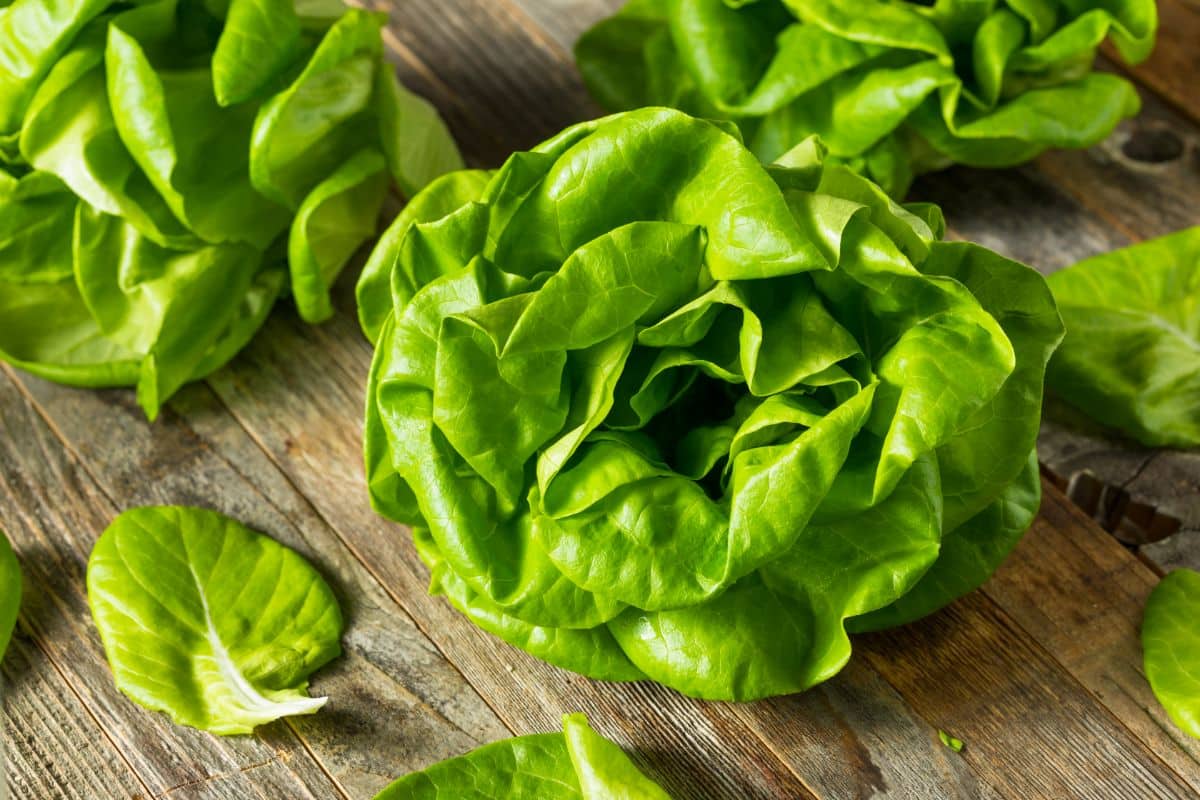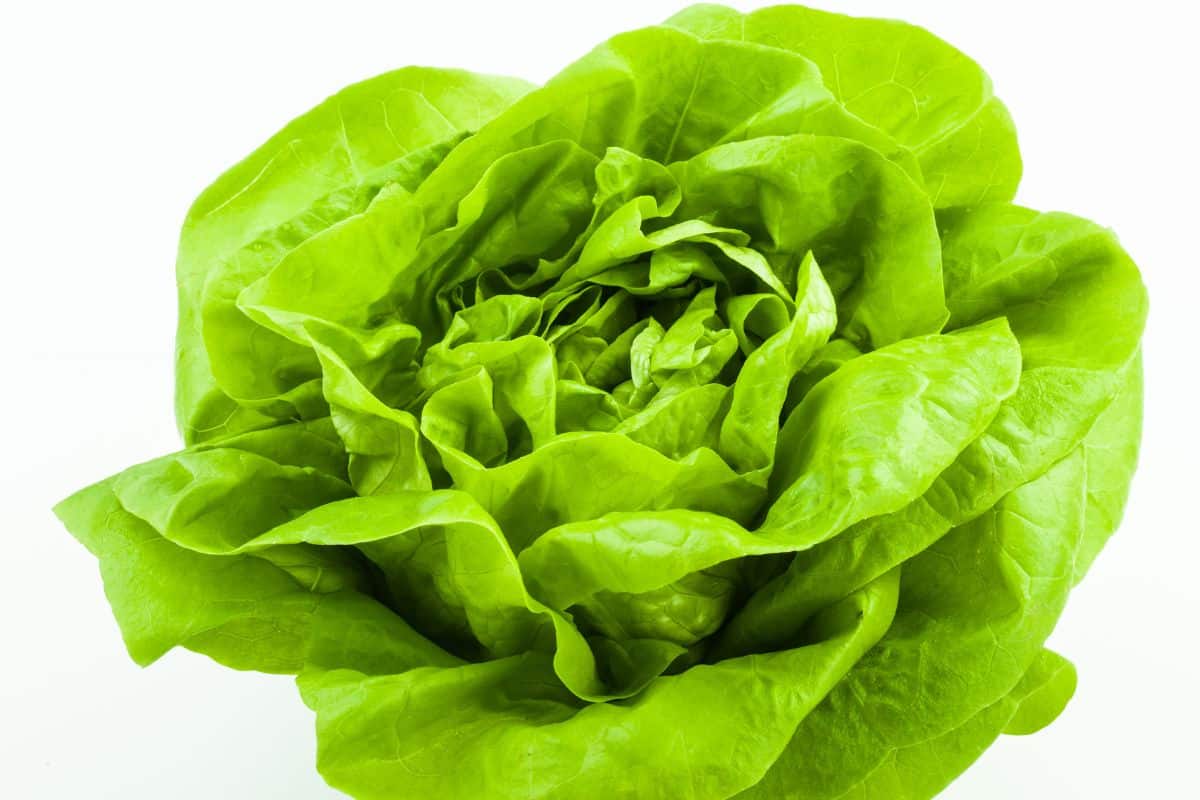Butter lettuce is a leafy green that has been gaining popularity recently. With its tender, delicate leaves and mild, sweet flavor, butter lettuce has become a favorite among health enthusiasts and foodies alike. But what exactly is butter lettuce?
In this article, we will explore the origins and characteristics of butter lettuce, as well as its nutritional benefits and culinary uses.

Whether you’re a seasoned salad connoisseur or simply curious about this versatile green, read on to discover all you need to know about butter lettuce!
What Is Butter Lettuce?
Butter lettuce, scientifically known as Lactuca sativa var. capitata, is a type of lettuce that belongs to the Asteraceae family.
It is characterized by its soft, buttery-textured leaves, hence the name “butter lettuce.” This variety of lettuce is known for its tender, loose heads, which form rosettes of loosely arranged leaves.
Butter lettuce leaves are typically light green to pale yellow, with a smooth and delicate texture. The leaves are more tender and less crunchy compared to other lettuce varieties, such as romaine or iceberg lettuce.
The mild and slightly sweet flavor of butter lettuce makes it a popular choice for salads and other culinary preparations.
This lettuce variety is often grown hydroponically or in cooler climates, as it prefers cooler temperatures and can be sensitive to heat.
It is commonly available in grocery stores and farmers’ markets, especially during the spring and summer months when it is in season.
Due to its delicate nature, butter lettuce is best consumed when fresh. It is typically enjoyed raw in salads, sandwiches, wraps, or used as a bed for other ingredients.
Its mild flavor pairs well with various dressings and toppings, allowing it to complement a wide range of flavors and ingredients.
The History Of Butter Lettuce
The history of butter lettuce dates back thousands of years. Lettuce, in general, is believed to have originated in the Mediterranean region, where it was cultivated and consumed by ancient Egyptians, Greeks, and Romans.
However, the specific origins of butter lettuce as a distinct variety are not well-documented.
Butter lettuce, or its ancestor varieties, was likely cultivated and enjoyed by ancient civilizations for its edible leaves.
Over time, through selective breeding and natural mutations, the characteristics of butter lettuce as we know it today began to emerge.
The name “butter lettuce” itself is a relatively modern term. It is believed to have originated in the late 19th century, possibly in the United States, where the soft and tender leaves were likened to the texture of butter.
The name captures the smooth, buttery quality of the lettuce leaves and has since become widely adopted.
In terms of commercial cultivation and popularity, butter lettuce gained prominence in the early 20th century.
The delicate texture and mild flavor appealed to consumers, and it became a preferred choice for salads and sandwiches.
Its popularity continued to grow over the years, with increased demand for fresh, healthy produce and the rise of culinary appreciation for different lettuce varieties.
Today, butter lettuce is grown and consumed worldwide. It is cultivated in various regions, including the United States, Europe, and Asia, with different cultivars adapted to different climates and growing conditions.
The Nutritional Benefits Of Butter Lettuce
Butter lettuce offers several nutritional benefits, making it a valuable addition to a balanced diet. Here are some of the key nutritional highlights of butter lettuce.
Low In Calories
Butter lettuce is a low-calorie food, making it a great choice for those looking to manage their calorie intake.
One cup of shredded butter lettuce contains only about 5-10 calories, depending on the specific variety.
Rich In Vitamins And Minerals
Butter lettuce is a good source of various vitamins and minerals. It is particularly rich in vitamin A, which is essential for healthy vision, immune function, and cell growth.
It also provides vitamin K, which is important for blood clotting and bone health. It also contains small amounts of vitamin C, vitamin E, folate, and potassium.

Antioxidant Properties
Like other leafy greens, butter lettuce contains antioxidants that help protect the body against harmful free radicals.
These antioxidants, including beta-carotene, vitamin C, and vitamin E, help reduce oxidative stress and inflammation, which are associated with chronic diseases.
Hydration
Butter lettuce has a high water content, which contributes to hydration. Staying hydrated is crucial for overall health and helps maintain various bodily functions, such as digestion, temperature regulation, and nutrient transport.
Dietary Fiber
While butter lettuce is not as high in fiber as some other leafy greens, it still contributes to your daily fiber intake.
Fiber promotes healthy digestion, aids in maintaining a feeling of fullness, and supports regular bowel movements.
Low In Sodium
Butter lettuce is naturally low in sodium, which makes it suitable for individuals following a low-sodium or heart-healthy diet.
Reducing sodium intake is important for managing blood pressure levels and overall cardiovascular health.
It’s worth noting that the nutritional content of butter lettuce can vary slightly depending on factors such as growing conditions and maturity.
However, incorporating butter lettuce into your meals can contribute to a well-rounded, nutrient-rich diet, supporting overall health and well-being.
Butter Lettuce Dishes
Butter lettuce is a versatile ingredient that can be used in a variety of dishes. Here are a few particularly popular butter lettuce dishes.
Butter Lettuce Salad
Create a refreshing salad by tossing torn butter lettuce leaves with your favorite toppings such as cherry tomatoes, cucumbers, avocado, radishes, and a light vinaigrette.
You can also add protein like shrimp, grilled chicken, or crumbled cheese for added flavor and texture.
Lettuce Wraps
Butter lettuce leaves make fantastic “wraps” for a healthy and low-carb meal. Fill the lettuce cups with a variety of fillings such as stir-fried vegetables, marinated tofu, seasoned ground meat, or even shrimp.
Sandwiches And Burgers
Replace traditional bread or buns with large butter lettuce leaves to create a lighter, gluten-free alternative.
Use them as a wrap for your favorite fillings, such as grilled chicken, turkey, tuna salad, or veggie patties. The lettuce adds a fresh crunch and a mild taste to your sandwiches.
Remember to wash and dry butter lettuce leaves thoroughly before using them in dishes. You will also want to handle it with care, as the delicate nature of the leaves requires gentle handling to avoid bruising or tearing.
Final Thoughts
Butter lettuce is a delightful leafy green that offers both culinary and nutritional benefits. With its tender, buttery-textured leaves and mild flavor, it has become a popular choice for all kinds of dishes.
Its rich history, spanning back to ancient civilizations, also highlights its enduring appeal and versatility in the kitchen.
So, the next time you’re at the grocery store or farmer’s market, consider picking up a head of butter lettuce and embark on a culinary adventure that celebrates this tender and mild leafy green!






